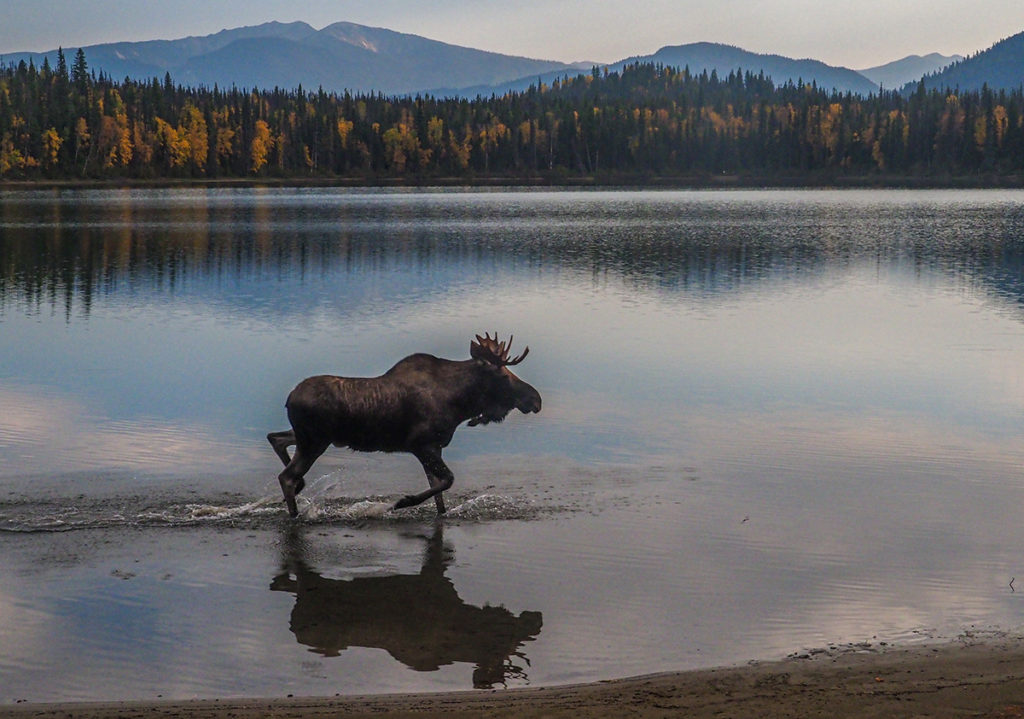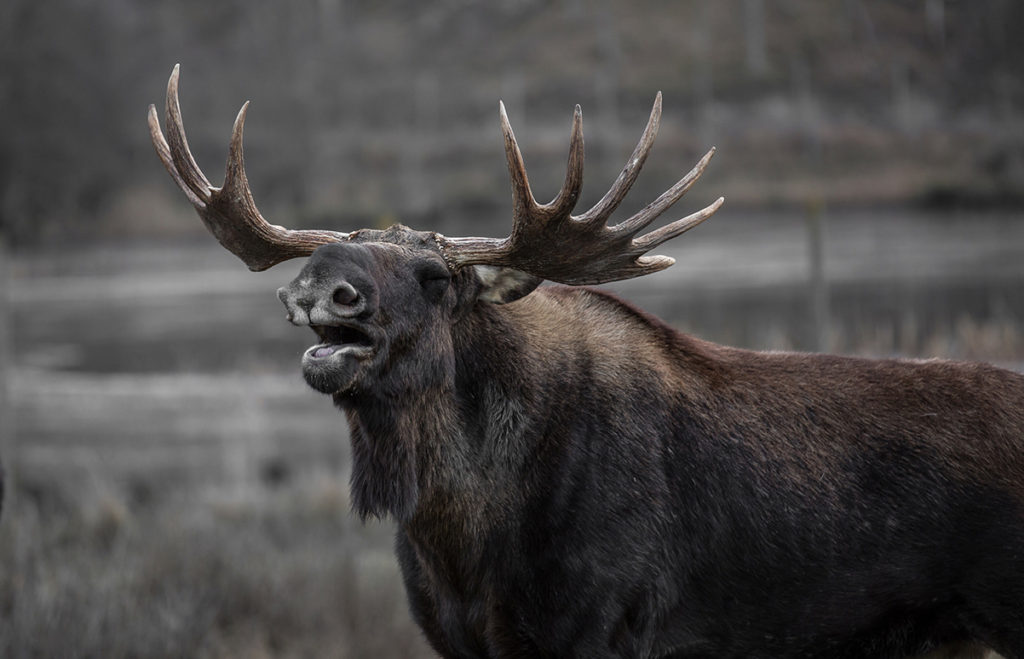Another resident of the Arctic and sub-Arctic regions, the majestic moose inhabits vast areas of the Northern hemisphere. However, they do not live just anywhere. The moose seeks forest and woodland for protection from predators and to forage for food. They also stay near sources of water such as lakes and wetlands. Moreover, they are often seen dipped in water cooling in the summer months. Because of this, many people assume moose eat fish. Nevertheless, moose are herbivores. So, what do moose eat? Read on to find out and a lot more.
Are All Moose the Same?
The simple answer is no. Moose, or elk in European countries, have many subspecies. The moose of North America have four recognised subspecies:
- Eastern moose found in Eastern Canada and Northeast US.
- Alaskan moose found in Alaska and Northwest Canada
- Northwest moose found in Central Canada, North Dakota, Minnesota and Northern Michigan.
- Shiras moose found in the Rocky Mountains.
The biggest differences between these subspecies is body size, antler size and fur. The largest moose live where conditions are best. This includes better variety of vegetation and fewer predators. Alaska is the perfect moose habitat. Although it is cold there, there are many plant species during spring and summer.
Moose are adapted for cold climates. They live in areas of thick snow, forests and high ridges. The thick snow offers protection from predators such as wolves. However, it cannot be too deep to inhibit their movement. Unlike many other species, moose migrate to colder areas in summer to avoid the warmer weather.
What Do Moose Eat? – Moose Diet
As mentioned above, moose love vegetation. They are surprisingly picky eaters and researchers have observed that moose prefer to eat the rarer plants when they are available. Moose diet consists of:
- Grasses
- Lichens
- Ferns
- Mosses
- Leaves
- Berries
- Tree bark: birch, yew & fir
- Aquatic plants: pondweed & water lillies
During summer, moose are often spotted standing in lakes or ponds. They will dip their heads under the water for almost a minute to reach the plants growing at the bottom. In winter months when vegetation is scarce, moose will strip bark and twigs from deciduous tree and bushes.
Due to their unique water feeding behaviour, many people believe that moose eat fish, but this is not true. Moose are strict herbivores, eating only plants and tree bark.
How Tall is a Moose? – Moose Appearance
All moose subspecies look the same, with differences in height and fur.
Alaskan moose are the largest, reaching heights as tall as 7 feet (2.1 meters) at the shoulder and weighing as much as 600kg. They also have thicker fur than moose found in warmer climates.
The Shiras moose by contrast only grows around 5 ft 6in tall and weighing approximately 450kg. Shiras moose have the darkest fur, appearing almost black in colour. Other moose subspecies have a lighter fur colour of a rich, walnut or chocolate brown.
All male bulls have antlers. As the moose ages, his antlers grow to be ever more impressive. The antlers are large and flat, with small horns or protrusions growing along the edges. Males use their antlers during the rutting season (breeding season) to defend their territory from other males and win the right to mate with any nearby females.
Also Read: What Do Arctic Wolves Eat?
Antlers are annual, meaning a bull will regrow his antlers every year. Antlers are shed after the mating season, which usually ends in late winter. Older males tend to shed earlier than young bulls. New antlers will grow a layer of velvet which is shed once the bone has matured.
Males also have a dewlap or “bell” that hangs under their neck. It is suggested by biologists and naturalists that this is somehow involved in attracting females, but the exact nature is unknown.
Female moose do not grow antlers and are not as large and tall as males. They have a wider pelvis than males to accommodate the birth of such a large calf. Females also have a lighter patch of fur just beneath their tail.
How Fast Can a Moose Run? – Moose Behaviour
Moose are generally slow, placid animals, spending their time moving through woods and meadows in search of plants and bushes to graze on. However, if a moose is startled or chasing another moose away from their territory, they can run very fast. A healthy adult moose is capable of running up to 35 miles an hour(57 km/h)!
Moose are cautious creatures, but those living in semi-rural areas have gotten used to venturing into people’s yards to eat the grass or trees. During summer, it is quite common to see moose calves playing in sprinklers while their mothers stay close by watching for danger.

Males are typically solitary, only searching out other moose during the breeding season. Female moose will rear the young and are not often seen alone. A juvenile moose will leave their mother around 1 year of age, by which time she will be pregnant again.
The only exception in North America is the Alaskan moose. They form harems lead by a dominant male who will defend them from other males. The victor has the right to mate with the females in the herd.
Moose are diurnal animals, meaning they are most active during the day. They will spend more time grazing in the early morning and late afternoon. There is often a lot of dew on vegetation in the mornings, so moose will get a lot of additional moisture if they eat (graze) at this time.
Moose Regularly Collide with Motorists
Moose are well known for being a hazard for motorists. Many states with moose populations have moose signs along rural roads. The tree line is also cut back from the road so drivers can see moose coming out of the trees. This gives the driver more time to react if a moose runs out in front of them.
There are hundreds of accidents every year of moose being hit by cars, but usually, the car comes off worse. Small cars are easily written off after colliding with a moose. The problem is that many roads have been built through moose territory, so they must cross roads in order to get to their feeding ranges.
Female Moose are Single Mothers – Breeding Season
Both males and females will scent mark on trees and call to one another using a variety of calls. Moose reach sexual maturity between 2 and 5 years old, with females usually maturing earlier. Breeding occurs every year between early September and the end of October. Gestation is around 230 days, which coincides with the beginning of spring.
Twins are relatively common in moose. A calf will weigh approximately 15kg at birth, gaining 1kg each day. They nurse from their mothers for the first few months until the mother starts rejecting their attempts. At this point, they will begin weaning onto grasses and plants.
Males take no part in the raising of offspring. They will leave the female after mating and return to their normal territory until the following year.
Lifespan for moose is between 8 and 15 years old, however, moose have been known to live into their mid-twenties.
What Does a Moose Sound Like? – Moose Communication
Moose are well known for their distinct calls and sounds. Females use a low moan that can last as long as 6 seconds. This is usually reserved for calling calves if they are out of sight. When females are in heat, they make long, quivered calls to attract nearby bulls.
During the rutting season, bulls will call to each other as a display of dominance. These calls are loud and can travel great distances. They also use a series of grunts as threats.
Moose calls sound like domestic cows, but louder, deeper and slightly longer in duration.
In addition to calls, moose will also scent mark by stripping bark off trees and rubbing their foreheads on the exposed tree trunk.

Do Orcas Eat Moose? – Moose Predators
In some areas of Canada and Alaska, there are a group of coastal islands close together that moose will often swim in between in search for food to eat. Orcas – sometimes called Killer Whales – will hunt in these areas as moose provide a lot of meat and can feed a large Orca pod. So, the answer is YES, orcas do eat moose and they are often easy prey for these extremely intelligent killers.
Nevertheless, the biggest predator of the moose is humans. In many areas of Canada and the US, there are annual hunting seasons where it is legal to hunt and kill big game like moose. Unfortunately, hunters prefer males due to their antlers and larger body weight. This means, in some areas, there are many more females than males, but the moose population is steady in most habitats.
Other predators include bears and wolves. Since moose are large animals, it can be dangerous for a lone predator to try and catch a male moose. They can do a lot of damage with their antlers. Wolves hunt in packs, so they do not have the same problem that a bear may have in avoiding injury during a hunt.
Five Fun Facts About the Moose
Here are some fascinating and little-known facts about moose:
- Moose have been known to dive as deep as 18-20 feet to reach aquatic plants!
- Moose are often filmed running alongside cars on rural roads, at speeds of 30-35mph.
- A moose call can be heard as far away as 3km.
- The shape of a moose’s nose helps it to chew pondweed while its head is under water.
- They have a valve in their nostrils that closes as water pressure increase to prevent the moose from drowning.
You might also be interested in: How to Keep a Log Cabin Warm in Winter?

